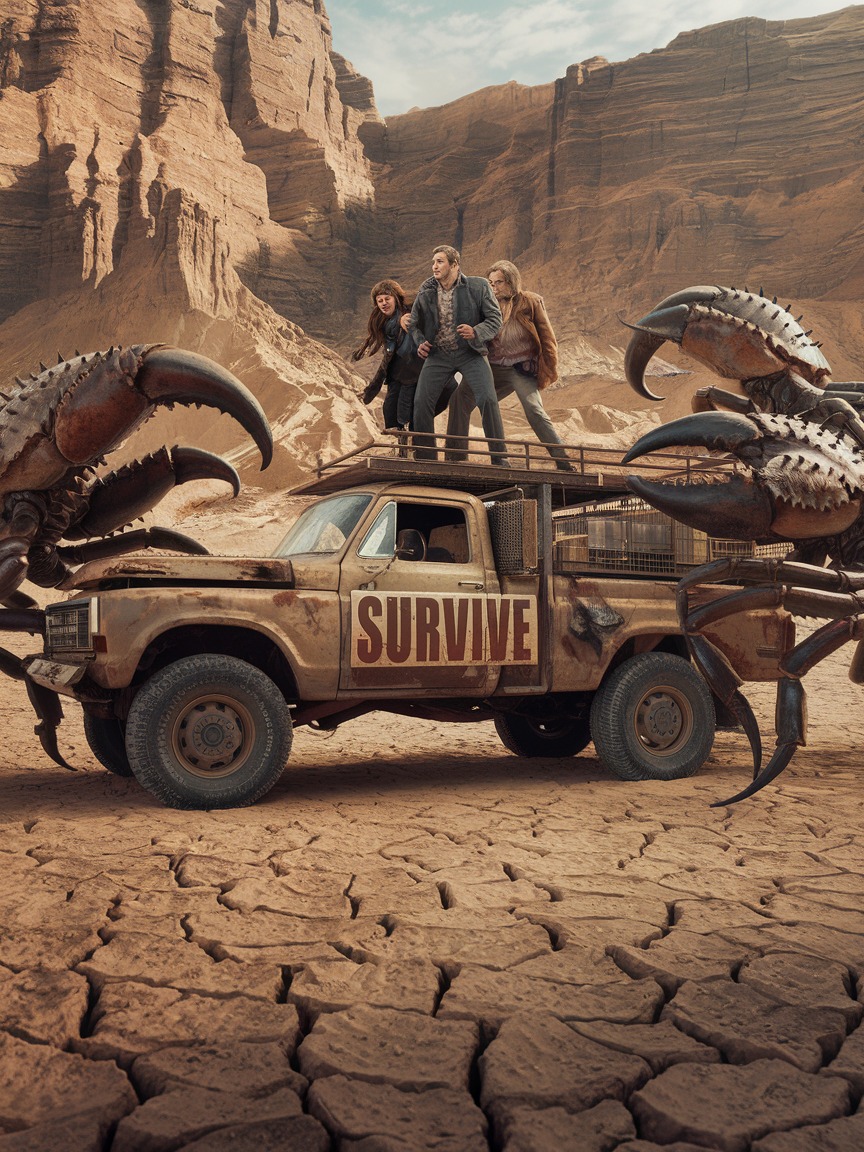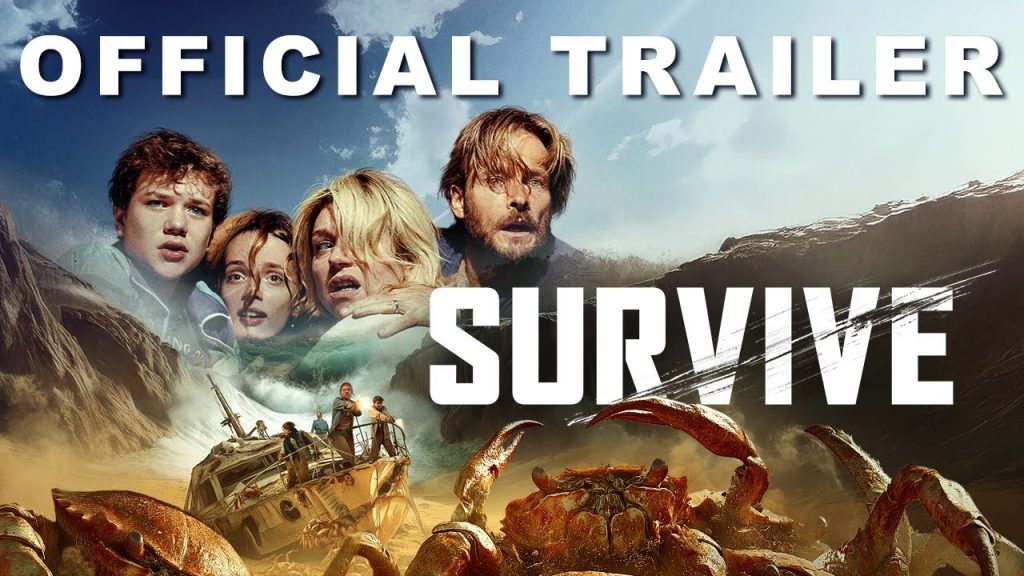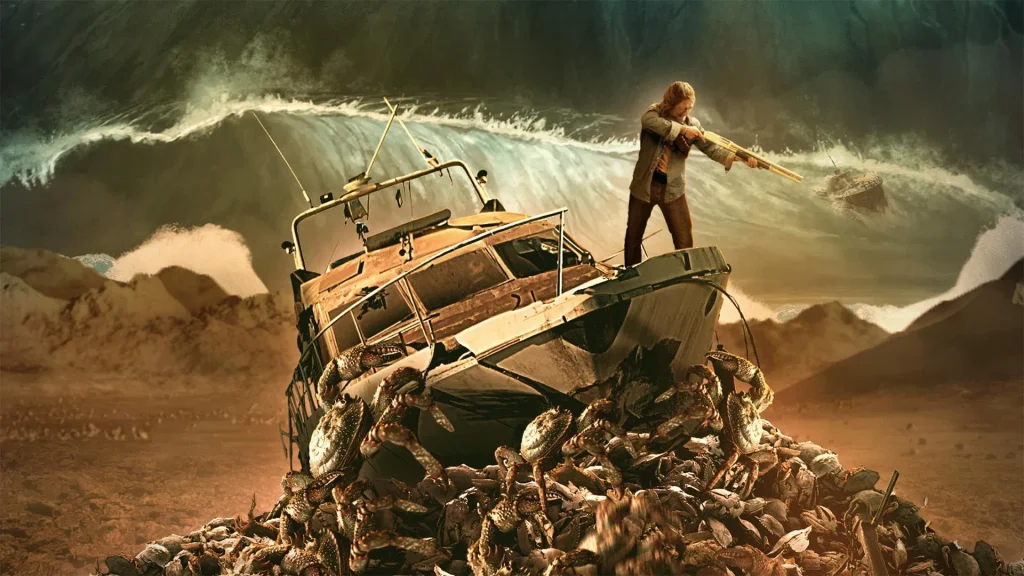Survive (2024)

Survive (2024): A Lean, Flawed Survival Thriller That Packs a Punch
Survive (2024), directed by Frédéric Jardin, is a French low-budget disaster-survival hybrid that throws a family into an apocalyptic nightmare after a geomagnetic pole reversal drains the oceans. Released on digital platforms in September 2024 in the UK and January 10, 2025, in the US, the film blends science fiction, horror, and family drama into a brisk 90-minute ride. Starring Émilie Dequenne, Andreas Pietschmann, Lisa Delamar, and Lucas Ebel, it’s a scrappy B-movie that swings big with its absurd premise but stumbles in execution. While it delivers moments of visceral tension and striking visuals, Survive struggles with tonal inconsistency, shallow characters, and a plot that prioritizes spectacle over logic. This review dives into every facet of the film—its story, craft, cast, and reception—to assess what works, what doesn’t, and whether it’s worth your time.
Plot Summary: A Family’s Fight in a World Turned Upside Down
Survive opens with a family of four—Julia (Émilie Dequenne), a doctor; Tom (Andreas Pietschmann), an oceanographer; and their teenage kids, Cassie (Lisa Delamar) and Ben (Lucas Ebel)—celebrating Ben’s 13th birthday on their yacht, the Orca, off the Cuban coast. The setup is idyllic: sun, sea, and familial banter. But warning signs creep in—a spinning compass, a sudden whirlpool, whales fleeing en masse. Then, a violent storm hits, hurling satellites from the sky and knocking the family out.
They awake to a surreal sight: their boat stranded on a desert wasteland, the ocean gone. Tom deduces a polarity reversal has shifted Earth’s magnetic field, draining the seas to flood landmasses—a scientifically dubious but cinematically bold conceit. Radio contact with Nao (Olivier Ho Hio Hen), a stranded submariner, reveals the water will return in a week, potentially drowning them. With only two spare seats in Nao’s submersible, the family treks across the exposed seabed, facing dehydration, a psychotic harpoon-wielding survivor (Arben Bajraktaraj), and a swarm of ravenous crabs from the ocean depths.
The narrative unfolds in three acts: the storm and aftermath, the desert journey with human threats, and a monster-movie climax with the crabs. It ends abruptly as the sea surges back, leaving Julia and her kids alive but stranded, their fate unclear. The plot prioritizes survival beats over explanation, leaning on action and emotion to carry the day.

Production: Low-Budget Ingenuity Meets Practical Constraints
Shot in 20 days on a €5 million budget in Morocco, Survive is a testament to resourcefulness. Jardin, known for Sleepless Night (2011), opts for practical locations over CGI excess. The Moroccan desert doubles as the dried ocean floor, littered with props like a wrecked jet and a beached shark—arresting images that sell the apocalypse on a dime. Cinematography by Laurent Tangy uses wide shots to capture the desolate expanse, paired with tight, handheld frames during action scenes for immediacy.
The storm sequence, though limited by budget, relies on sound design and editing to convey chaos—crashing waves, howling wind, and debris raining down. The crabs, a late-act twist, mix practical effects and modest CGI, effective in close-ups but clunky in wider shots. Nicolas Errèra’s score is energetic, driving tension, though it occasionally overcues emotions, undermining subtlety.
Producers Marc-Étienne Schwartz and Marco Stanimirovic, genre enthusiasts, pushed the project through M.E.S. Productions and Monkey Pack Films, with C8 Films co-financing. Writers Alexandre Coquelle and Mathieu Oullion crafted a script that’s lean but overstuffed, cramming disaster, survival, and creature-feature elements into a tight runtime. The result is a film that feels both ambitious and rushed, its low budget a strength in its rawness but a weakness in polish.
Performances: Solid Leads, Uneven Ensemble
Émilie Dequenne anchors Survive as Julia, a mother thrust into heroism. Her physicality—running, fighting, dragging her kids to safety—grounds the film’s chaos. Dequenne’s best moments are silent: a weary glance at the horizon, a desperate lunge at a crab. She sells the maternal instinct theme, even when the script gives her little depth beyond “save the kids.”
Andreas Pietschmann’s Tom is the exposition machine, delivering pseudoscience with conviction. He’s likable as the supportive dad, but his early death—impaled by the psycho—cuts his arc short, leaving the family dynamic lopsided. Pietschmann does well with what he’s given, though his bilingual English-French delivery feels forced, a nod to the film’s international cast.
Lisa Delamar’s Cassie is the standout among the kids, channeling teenage angst into relatable frustration—video-chatting her boyfriend mid-crisis, sulking at her brother. Ascendant in the storm scene, she’s petulant but grows tougher as threats mount. Lucas Ebel’s Ben is less defined, a wide-eyed birthday boy whose balloon release unwittingly draws the psycho. Ebel’s earnestness works, but his character’s naivety borders on caricature, especially in reckless moments like wandering off alone.
Arben Bajraktaraj’s unnamed maniac is a stock villain—limping, wild-eyed, harpoon in hand. He’s a plot device, not a person, existing to raise stakes but lacking motive beyond “crazy survivor.” Olivier Ho Hio Hen’s Nao is underused, a calm voice of reason who barely appears onscreen, his submersible a dangling carrot that never pays off fully.
The acting is competent but hampered by thin dialogue and rushed pacing. The family speaks English initially, then shifts to French, reflecting their Miami-based bilingualism—a detail that’s realistic but jarring without context.
Themes: Survival, Family, and Environmental Subtext
Survive wears its themes lightly. Survival is the core—each obstacle tests the family’s endurance, from thirst to crab attacks. Julia’s shift from doctor to warrior-mom highlights parental sacrifice, a thread echoed in Tom’s fatal stand to protect his kids. Sibling rivalry between Cassie and Ben simmers but doesn’t resolve, a missed chance for emotional heft.
An eco-warning lurks beneath: the opening crawl notes Earth’s five mass extinctions, hinting at a sixth. Nao muses, “Maybe the Earth has decided to eliminate men before they destroy it.” It’s a nod to climate anxiety, but the film doesn’t dwell, favoring action over preaching. The polarity flip, while nonsense scientifically, symbolizes nature’s wrath—a blunt metaphor that lands visually, not intellectually.

Strengths: Visual Flair and Pulpy Thrills
Survive shines in its imagery. The boat exploding in the desert, bats fleeing a crashed jet, a hammerhead gasping in a puddle—these snapshots, cribbed from surrealists like Moebius, stick with you. The crab swarm, absurd as it is, delivers a jolt akin to Tremors—fast, toothy, and relentless. Jardin’s direction keeps things moving; at 90 minutes, it never drags.
The film’s B-movie charm is its heart. It’s not deep, but it’s fun—perfect for a late-night watch with popcorn. Dequenne’s grit and the desert’s stark beauty elevate it beyond schlock, while the premise’s sheer audacity earns respect. It’s a survival tale that embraces its limits, turning a €5 million budget into a gritty, visceral experience.
Weaknesses: Logic Gaps, Tonal Whiplash, and a Rushed End
The plot’s foundation—polarity reversal draining oceans—is laughably implausible. Water wouldn’t vanish overnight, nor would crabs evolve into land predators in hours. The film shrugs off these holes, but they nag at anyone paying attention. Why’s the seabed a desert, not a muddy mess? Where’d the fish go? Suspension of disbelief only stretches so far.
Tonally, Survive lurches from family drama to disaster flick to slasher horror to creature feature. The psycho’s subplot feels tacked on, and the crabs’ late arrival jars after a grounded first half. Pacing falters mid-film—tense scenes cut short by contrived twists, like Ben’s balloon stunt or Cassie’s dumb detours. Characters make baffling choices, like lingering near danger instead of fleeing, eroding sympathy.
The ending is a letdown. The sea returns, washing away threats but leaving Julia and the kids adrift—no closure, no catharsis. It’s as if the budget ran out, snipping a climax that deserved more. Subplots—like Cassie’s boyfriend or Nao’s rescue—dangle unresolved, frustrating viewers who stuck it out.
Reception: Polarized Views from Critics and Fans
Critics split on Survive. The Guardian praised its “smart, surrealist” visuals and “raw” family focus, calling it a low-budget win. Roger Ebert.com lauded its “silly and adventurous” spirit, rating it a sturdy thriller for crab fans. But Why Tho? found it “boring” despite potential, faulting its lack of urgency. IMDb users average it at 4.6/10—some decry it as “épouvantable” and “an insult to intellect,” others enjoy its “70s-style apocalyptic fun.”
At FrightFest 2024, where it premiered, it drew cheers for its gonzo energy but groans for pacing and plot holes. Letterboxd reviews range from “ridiculous but watchable” to “lacking tension and stakes.” It’s a love-it-or-hate-it flick—divisive yet memorable.

Cultural Impact: A Niche Entry in Disaster Cinema
Survive joins a lineage of disaster films like The Day After Tomorrow and Mad Max, minus their scale or polish. It’s closer to 70s B-movies—Damnation Alley or The Last Woman on Earth—with a French twist. Its eco-angle taps 2024’s climate fears, but its execution limits mainstream reach. It’s unlikely to shift culture, instead carving a cult niche for genre buffs who crave weird, scrappy thrills over coherence.
Final Verdict: Flawed but Fierce
Survive isn’t a masterpiece. Its science is bunk, its characters thin, its ending abrupt. Yet it’s got guts—visual flair, a game cast, and a premise so wild it’s hard to look away. Dequenne holds it together, and the crabs deliver a late-game kick. At 90 minutes, it’s a tight, pulpy escape—best enjoyed with low expectations and high tolerance for nonsense. It’s not Top Gun 3’s blockbuster polish, but for a €5 million gamble, it punches above its weight. Worth a stream if you’re in the mood for something strange and scrappy.
Score: 6.5/10. A flawed fighter that lands enough blows to stay in the ring.